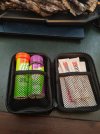Are you fully hydrated,
@Newbie777? Particularly during the night.
Libre is sampling your interstitial fluid, not quite the same blood that you take a drop from for your fingerprick test. If you are not fully hydrated then it is likely your brain will give hydration priority to actual blood at the expense of interstitial fluid. Many people, as they get older, deliberately or subconsciously cut back on liquids in the evenings to reduce their need to pass urine in the middle of the night and the conseuent aleep disruption. This is particularly so for males with prostate enlargement (and Urology advice for such males specifically includes instructions to stop fluid intake well before bedtime).
True hypo is medically set at 3.5 mmol/L. We use the figure of 4 partly because it's historic; a convenient round number ("4 is the floor" is easy to remember); and it provides an initial factor of safety when our mental capacity is impeded during very low BG.
Also home blood testing is done using mass produced equipment for a limited market (people with Diabetes) yet available at an affordable price; there is an inevitable degree of inaccuracy within all blood testing at home. While a screen displays a number to within one decimal point, in practice the equipment is simply not that accurate. CGM worsens the perception of accuracy, yet CGM does give accurate graphs for showing predicted trend. CGM is sampling every single minute, displaying something every 5 minutes and using a "secret" (commercially sensitive) algorithm (mathematical trickery) to derive the best (manipulated) average with secret adjustments to compensate for the known (10-15 minutes) lag of interstitial fluid behind actual blood glucose. The permitted tolerances for both home testing BG meters or CGM is +/- 15%; these are Internationally agreed tolerances, arrived at after clever medical and commercial people have wrestled long and hard at accepting a compromise between medical safety and commercial viability.
So it is sensible and practical to use the numerical data with a degree of caution and to take steps to simply avoid hypos. Why go near 4 mmol/L when you have tech that can "Alert" you from 5.6 that your BG is falling? Why an "Alarm" that panics you at 4.2 (or any number close to 4) when you might already be in or very close to a hypo state?
Your body will run perfectly well if you had a target to be above 5.5 (but below 10) and the older you get the more you can allow that figure to increase. Hypos are best avoided in the short term (day by day) because they are downright inconvenient and unoleasant; but also because of the long term potential for cognitive impairment with age.
If your CGM tells you that you are aporoaching a hypo state, VERIFY that with a finger prick, unless of course your own internal hypo awareness signals are already telling you. We can all be guilty of over- reacting. Indeed we have to some extent primed ourselves to need to overreact by using the "Alarm" response process; modern lifestyles are built around last minute planning, decision making - encouraged by smart phone tech sending reminders by endless texts, emails etc plus gadgets/widgets/apps providing notifications.
Treat hypos initially ONLY with high glucose rapid response treatments. An apple does not provide that. Dextrose, jelly babies or high carb drinks like orange juice & coke @ 8-10% do. WAIT 15 minutes, confirm with a finger prick that recovery is happening and if not, REPEAT. Once the hypo has ended it often helps to consolidate with a small amount of medium level carbs, such as a biscuit or a round of toast. But do NOT DILUTE the high glucose response with low or medium glucose extras - at the same time. Give the high glucose response time to work, then consolidate that success. It is very tempting to overdo things (and when our BG is truly low the mental confusion it causes makes us want to empty the cupboards/larders/fridges) - right now.
Reading your posts,
@Newbie777, leaves me thinking you are setting yourself up for high Glycaemic Variability: most of the time you are trying to be low carb, then your hypo response is excessive leading to that inevitable hyper backlash.
All of this is just my (middle of the night) non-medical opinion. We are all different, with different detailed medical responses and different social and familial influences/constraints.

